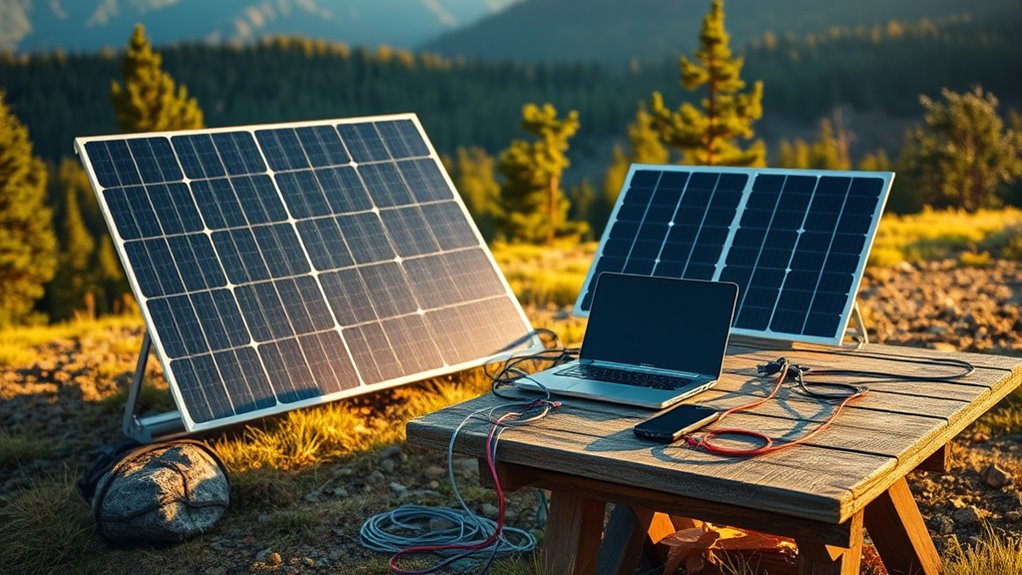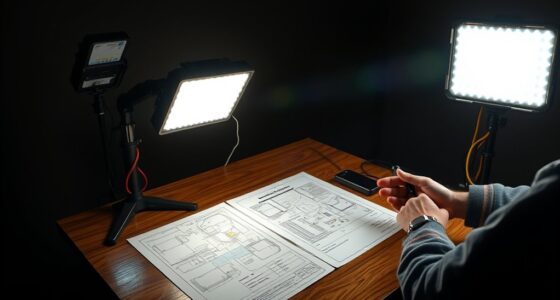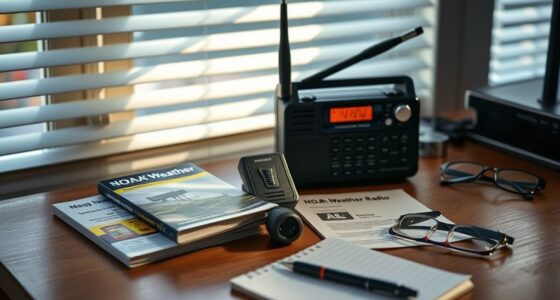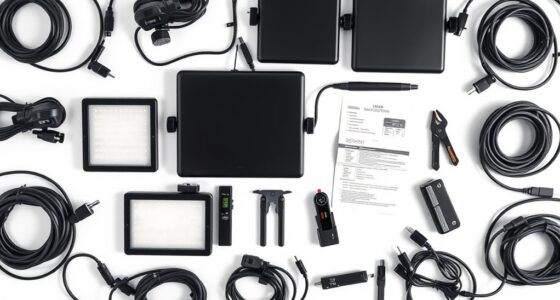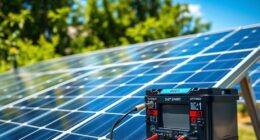To charge your laptops and devices off-grid, you’ll need a portable solar power system that combines solar panels and a built-in or separate battery pack. These systems capture sunlight, convert it to electricity, and store energy for use when sunlight isn’t available. You can connect your devices directly or use the stored power for continuous operation. Keep exploring to find out how you can build or choose the best off-grid charging setup for your needs.
Key Takeaways
- Use portable solar chargers with compatible wattage to directly power or charge laptops and devices off-grid.
- Incorporate battery storage systems to store excess solar energy for continuous device charging during low sunlight.
- Select lightweight, durable solar panels suitable for outdoor environments to maximize sunlight capture in remote areas.
- Combine solar panels with high-capacity portable batteries for extended off-grid device use without external power sources.
- Ensure devices are compatible with the power output of the off-grid system to prevent damage and ensure efficient charging.
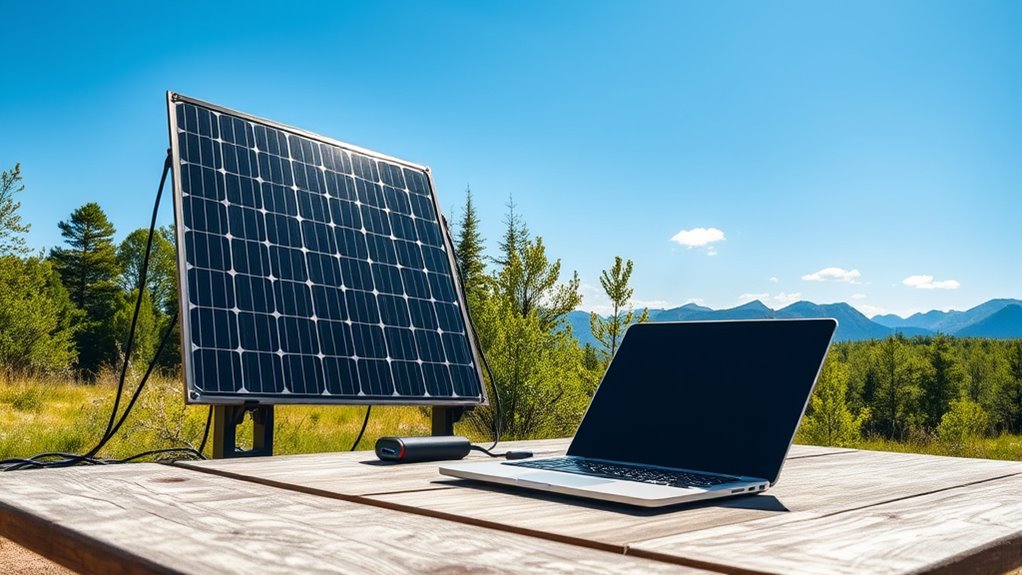
Charging laptops and devices off-grid has become more practical than ever, thanks to advancements in portable power solutions. If you’re heading into the wilderness, planning a camping trip, or simply looking to stay connected without relying on traditional power sources, understanding how solar power and battery storage work together is essential. These technologies enable you to generate and store energy efficiently, making off-grid charging a seamless experience.
Solar power is at the heart of many portable off-grid charging systems. You can set up a compact solar panel in a sunny spot, and it will convert sunlight into usable electricity. Modern solar panels are lightweight, durable, and highly efficient, allowing you to gather ample energy even during cloudy days. When sunlight hits the panel, it generates direct current (DC) power, which then needs to be stored or converted for your devices. This is where battery storage comes into play.
Battery storage units act as the backbone of off-grid power setups. They store excess energy generated during the day so you can charge your devices at night or during overcast conditions. These batteries are designed to handle multiple charge-discharge cycles, making them reliable over time. When you connect your laptop or other devices to a portable power station or a battery pack, the stored energy supplies a steady, clean power source. This setup ensures that your devices remain charged without interruption, regardless of sunlight availability.
The synergy between solar power and battery storage offers flexibility and independence. For example, on a sunny day, your solar panel charges the battery while powering your devices simultaneously. When the sun sets, you can draw from the stored energy in your batteries to keep your laptop running. This setup not only extends your off-grid capabilities but also reduces the need for frequent recharges or carrying heavy, traditional power sources.
Furthermore, these systems are becoming increasingly user-friendly. Many portable solar chargers come with built-in batteries, allowing you to connect multiple devices directly. Others require a separate battery pack, which you can recharge with sunlight or an AC outlet before heading out. The key is to select a system that matches your power needs, considering the wattage of your devices and the expected duration off-grid. Understanding off-grid power solutions can help you choose the right equipment that balances capacity and portability for your specific needs.
Frequently Asked Questions
What Are the Best Portable Power Banks for Off-Grid Laptop Charging?
You should consider power banks with high battery capacity ratings, like the Jackery Explorer 1500 or the Anker PowerHouse 200, for off-grid laptop charging. Look for models with excellent solar panel efficiency to recharge easily using sunlight. These devices provide reliable power, ensuring your laptop stays charged even in remote areas. Opt for those with multiple output ports and fast charging features to make your off-grid experience smooth and efficient.
How Long Can a Solar Generator Power a Laptop Continuously?
You can power a laptop for about 4 to 8 hours with a solar generator, depending on its battery capacity estimation and your laptop’s power needs. Regular solar panel maintenance guarantees peak efficiency, which impacts runtime. Keep in mind, if your solar panel’s performance drops by just 10%, your runtime decreases accordingly. So, understanding your generator’s capacity and maintaining your solar setup helps you maximize off-grid laptop use.
Are There Eco-Friendly Options for Off-Grid Device Charging?
Yes, you can choose eco-friendly options like biodegradable batteries and wind-powered chargers. Biodegradable batteries reduce environmental impact when they’re disposed of, making them ideal for off-grid use. Wind-powered chargers harness renewable energy, providing a sustainable way to charge your devices without relying on fossil fuels. Combining these options helps you stay connected while minimizing your ecological footprint, making off-grid charging both practical and environmentally responsible.
Can I Charge Multiple Devices Simultaneously Off-Grid?
Yes, you can charge multiple devices simultaneously off-grid, like a symphony of power flowing from your portable setup. With a high battery capacity, you can support several gadgets at once, provided your power station is compatible with each device. Always check device compatibility and guarantee your charger can handle the total power draw. This way, you keep all your devices powered without missing a beat while off the grid.
What Safety Precautions Are Necessary When Charging Devices Off-Grid?
When charging devices off-grid, you need to prioritize battery safety by avoiding overcharging and monitoring temperature. Always guarantee proper grounding of your power setup to prevent electrical shocks or damage. Use quality cables and connectors, and keep your equipment away from water or moisture. Regularly inspect your batteries and connections to maintain safety and efficiency, reducing the risk of fire or electrical hazards during off-grid charging.
Conclusion
Now that you know how to charge your laptops and devices off-grid, you’re ready to embrace the freedom of mobile power. With a reliable solar setup or portable power station, you can stay connected no matter where your adventures take you—be it a forest or a castle. Just remember, even in this modern age, ancient wisdom reminds us to respect nature’s energy and harness it wisely. Your off-grid journey awaits, noble traveler.
